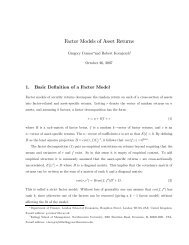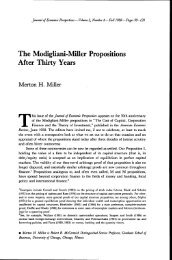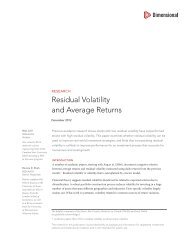Campbell, John Y, Jens Hilscher and Jan Szilagyi, 2005.
Campbell, John Y, Jens Hilscher and Jan Szilagyi, 2005.
Campbell, John Y, Jens Hilscher and Jan Szilagyi, 2005.
Create successful ePaper yourself
Turn your PDF publications into a flip-book with our unique Google optimized e-Paper software.
4 Risks <strong>and</strong> average returns on distressed stocksWe now turn our attention to the asset pricing implications of our failure model.Recent work on the distress premium has tended to use either traditional risk indicessuch as the Altman Z-score or Ohlson O-score (Dichev 1998, Griffin <strong>and</strong>Lemmon2002, Ferguson <strong>and</strong> Shockley 2003) or the distance to default measure of KMV (Vassalou<strong>and</strong> Xing 2004, Da <strong>and</strong> Gao 2004). To the extent that our reduced-form modelmore accurately measures the risk of failure at short <strong>and</strong> long horizons, we can moreaccurately measure the premium that investors receive for holding distressed stocks.Before presenting the results, we ask what results we should expect to find. Onthe one h<strong>and</strong>, if investors accurately perceive the risk of failure they may dem<strong>and</strong> apremium for bearing it. The frequency of failure shows strong variation over time, asillustrated in Figure 1; even though much of this time-variation is explained by timevariationinourfirm-levelpredictive variables, it still generates common movementin stock returns that might comm<strong>and</strong> a premium.Of course, a risk can be pervasive <strong>and</strong> still be unpriced. If the st<strong>and</strong>ard implementationof the CAPM is exactly correct, for example, then each firm’s risk is fullycaptured by its covariation with the market portfolio of equities, <strong>and</strong> distress risk isunpriced to the extent that it is uncorrelated with that portfolio. However it seemsplausible that corporate failures may be correlated with declines in unmeasured componentsof wealth such as human capital (Fama <strong>and</strong> French 1996) or debt securities(Ferguson <strong>and</strong> Shockley 2003), in which case distress risk will carry a positive riskpremium. 8 This expectation is consistent with the high failure risk of small firms thathave depressed market values, since small value stocks are well known to deliver highaverage returns.8 Fama <strong>and</strong> French (1996) state the idea particularly clearly: “Why is relative distress a statevariable of special hedging concern to investors? One possible explanation is linked to humancapital, an important asset for most investors. Consider an investor with specialized human capitaltied to a growth firm (or industry or technology). A negative shock to the firm’s prospects probablydoes not reduce the value of the investor’s human capital; it may just mean that employment in thefirm will grow less rapidly. In contrast, a negative shock to a distressed firm more likely implies anegative shock to the value of human capital since employment in the firm is more likely to contract.Thus, workers with specialized human capital in distressed firms have an incentive to avoid holdingtheir firms’ stocks. If variation in distress is correlated across firms, workers in distressed firmshave an incentive to avoid the stocks of all distressed firms. The result can be a state-variable riskpremium in the expected returns of distressed stocks.” (p.77).17





